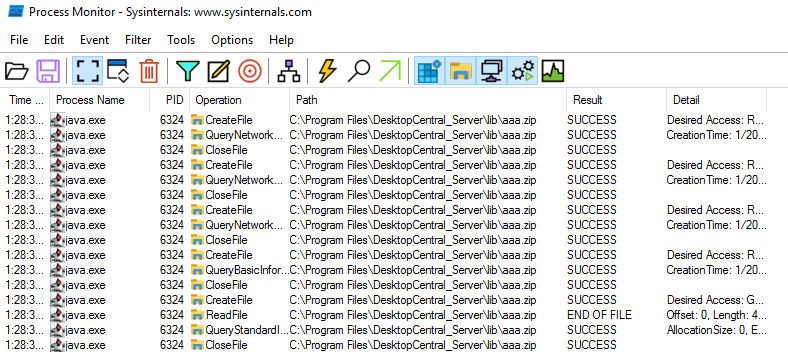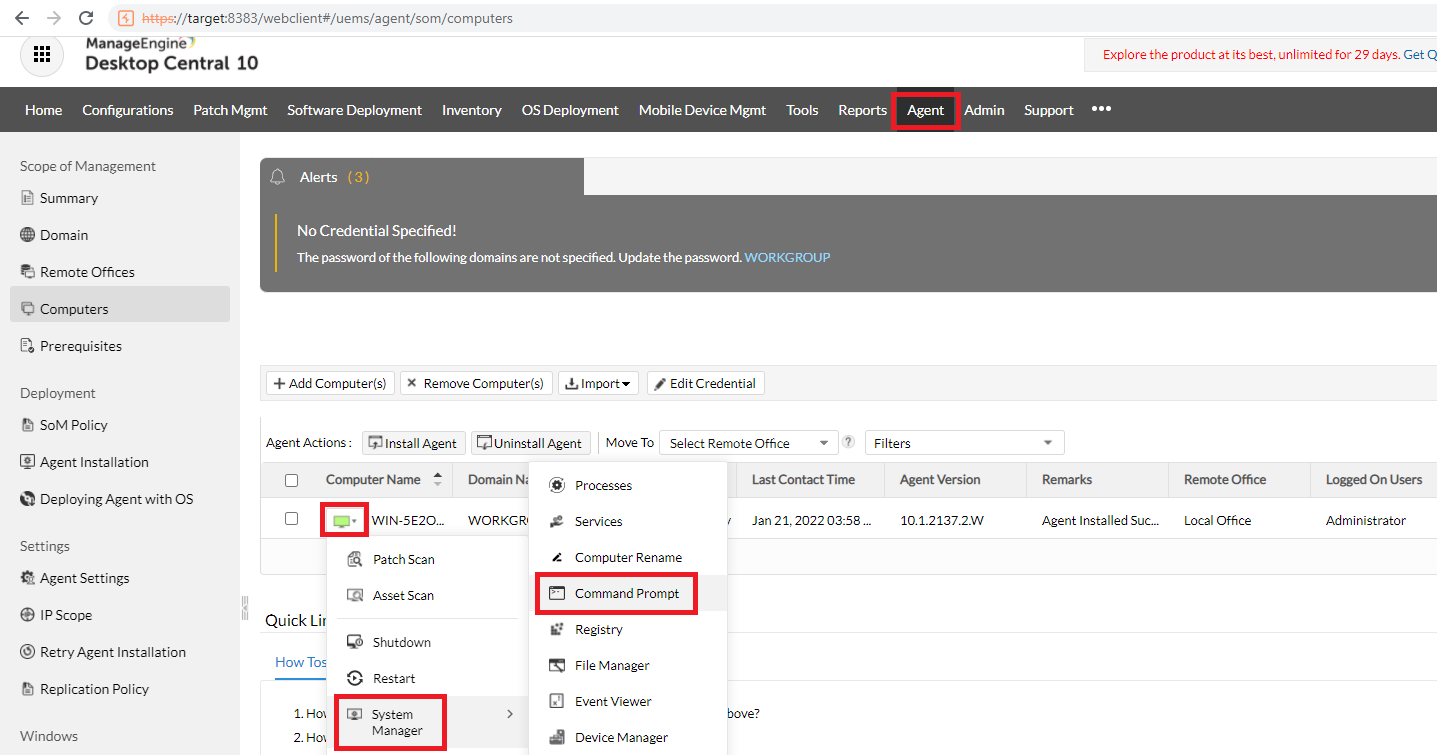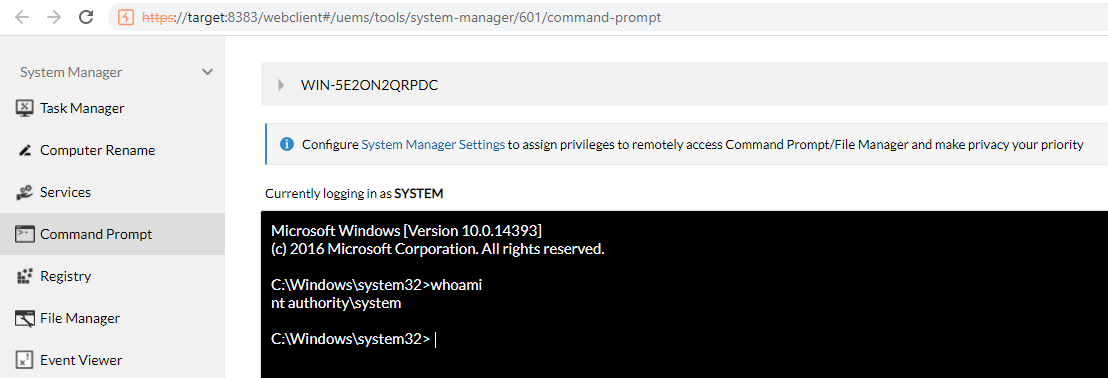ZohOwned :: A Critical Authentication Bypass on Zoho ManageEngine Desktop Central

On December 3, 2021, Zoho released a security advisory under CVE-2021-44515 for an authentication bypass in its ManageEngine Desktop Central and Desktop Central MSP products. On December 17, 2021, the FBI published a flash alert, including technical details and indicators of compromise (IOCs) used by threat actors. Shortly after, William Vu published an Attackerkb entry after doing some static analysis. Meanwhile during the whole of December, I was on holidays!
Why did this matter? Well, as it turns out I was sitting on a few bugs I had found in Desktop Central when I audited it back in December 2019. One of them, being an authentication bypass and after reading the FBI report I quickly relized we were dealing with the same zeroday!
At the time, I could only exploit the bug to trigger a directory traversal and write a zip file onto the target system (the same bug that was used in the wild). Since I didn’t have any vector for exploitation and I already had CVE-2020-10189 handy, I decided to leave it alone and include it as part of my Full Stack Web Attack training within module-5 (A zero-day hunt in ManageEngine Desktop Central). I even hinted to a partial authentication bypass to some students! ;->
So after coming back from holidays, I decided to give the bug some justice and understand/improve on the attack that the threat actors pulled off. First though, what is it we are dealing with here?
StateFilter Arbitrary Forward Authentication Bypass Vulnerability
Inside of the web.xml file we find the following entry:
<filter>
<filter-name>StateFilter</filter-name>
<filter-class>com.adventnet.client.view.web.StateFilter</filter-class>
</filter>
<filter-mapping>
<filter-name>StateFilter</filter-name>
<url-pattern>/STATE_ID/*</url-pattern>
</filter-mapping>
Filters are triggered pre-authenticated and often used to validate clientside data such as csrf tokens, sessions, etc. Let’s check the doFilter method:
/* */ public void doFilter(ServletRequest request, ServletResponse response, FilterChain chain) throws IOException, ServletException {
/* */ try {
/* 41 */ Long startTime = new Long(System.currentTimeMillis());
/* 42 */ request.setAttribute("TIME_TO_LOAD_START_TIME", startTime);
/* 43 */ logger.log(Level.FINEST, "doFilter called for {0} ", ((HttpServletRequest)request).getRequestURI());
/* 44 */ StateParserGenerator.processState((HttpServletRequest)request, (HttpServletResponse)response); // 1
/* 45 */ String forwardPath = ((HttpServletRequest)request).getRequestURI();
/* 46 */ if (!WebClientUtil.isRestful((HttpServletRequest)request) || forwardPath.indexOf("STATE_ID") != -1) { // 8
/* */
/* 48 */ String path = getForwardPath((HttpServletRequest)request); // 9
/* 49 */ RequestDispatcher rd = request.getRequestDispatcher(path); // 10
/* 50 */ rd.forward(request, response); // 11
/* */ }
/* */ //...
At [1] the code calls stateParserGenerator.processState with the attacker controlled request:
/* */ public static void processState(HttpServletRequest request, HttpServletResponse response) throws Exception {
/* 288 */ if (StateAPI.prevStateDataRef.get() != null) {
/* */ return;
/* */ }
/* */
/* 292 */ Cookie[] cookiesList = request.getCookies();
/* 293 */ if (cookiesList == null)
/* */ {
/* 295 */ throw new ClientException(2, null);
/* */ }
/* */
/* */
/* 299 */ TreeSet set = new TreeSet(new StateUtils.CookieComparator()); // 2
/* 300 */ String contextPath = request.getContextPath();
/* 301 */ contextPath = (contextPath == null || contextPath.trim().length() == 0) ? "/" : contextPath;
/* */
/* 303 */ String sessionIdName = request.getServletContext().getSessionCookieConfig().getName();
/* 304 */ sessionIdName = (sessionIdName != null) ? sessionIdName : "JSESSIONID";
/* */
/* 306 */ for (int i = 0; i < cookiesList.length; i++) {
/* */ //...
/* 316 */ String cookieName = cookie.getName();
/* */ //...
/* 334 */ if (cookieName.startsWith("_")) {
/* */
/* 336 */ cookiesList[i].setPath(contextPath);
/* 337 */ response.addCookie(cookiesList[i]);
/* */ }
/* 339 */ else if (cookieName.startsWith("STATE_COOKIE")) {
/* */
/* 341 */ set.add(cookiesList[i]); // 3
/* */ }
/* */ //...
/* 369 */ if (set.size() == 0) { // 4
/* */
/* 371 */ request.setAttribute("STATE_MAP", NULLOBJ);
/* 372 */ if (!WebClientUtil.isRestful(request))
/* */ {
/* 374 */ throw new ClientException(2, null);
/* */ }
/* */ return;
/* */ }
/* 378 */ Iterator iterator = set.iterator();
/* 379 */ StringBuffer cookieValue = new StringBuffer();
/* 380 */ while (iterator.hasNext()) {
/* 381 */ Cookie currentCookie = (Cookie)iterator.next();
/* 382 */ String value = currentCookie.getValue();
/* 383 */ cookieValue.append(value);
/* */ }
/* 385 */ request.setAttribute("PREVCLIENTSTATE", cookieValue.toString());
/* 386 */ Map state = parseState(cookieValue.toString()); // 5
/* */ //...
/* 388 */ Iterator ite = state.keySet().iterator();
/* 389 */ while (ite.hasNext()) {
/* */
/* 391 */ String uniqueId = (String)ite.next();
/* 392 */ Map viewMap = (Map)state.get(uniqueId);
/* 393 */ refIdVsId.put(viewMap.get("ID") + "", uniqueId);
/* */ }
/* 395 */ StateAPI.prevStateDataRef.set((state != null) ? state : NULLOBJ);
/* 396 */ if (state != null) {
/* */
/* 398 */ if (!WebClientUtil.isRestful(request)) {
/* */
/* 400 */ long urlTime = getTimeFromUrl(request.getRequestURI());
/* 401 */ long reqTime = Long.parseLong((String)StateAPI.getRequestState("_TIME")); // 6
/* 402 */ ((Map)state.get("_REQS")).put("_ISBROWSERREFRESH", String.valueOf((urlTime != reqTime && !StateAPI.isSubRequest(request)))); // 7
/* */ }
In order to survive StateParserGenerator.processState, the attacker will need to populate the TreeSet at [2] with a STATE_COOKIE at [3] so that they don’t crash and burn at [4]. Also, the attacker needs to use StateParserGenerator.processState method at [5] to craft a special state map containing values to survive [6] and [7]. There is no way to return null from StateParserGenerator.parseState, I already thought of that!
Once the attacker can proceed past StateParserGenerator.processState, they can set forwardPath at [8] with the provided URI and subsequently set path at [9]
/* */ private String getForwardPath(HttpServletRequest request) {
/* 88 */ String path = request.getContextPath() + "/STATE_ID/";
/* 89 */ String forwardPath = request.getRequestURI();
/* 90 */ if (!forwardPath.startsWith(path))
/* */ {
/* 92 */ return forwardPath;
/* */ }
/* 94 */ int index = forwardPath.indexOf('/', path.length());
/* 95 */ if (WebClientUtil.isRestful(request)) {
/* */
/* 97 */ forwardPath = forwardPath.substring(path.length() - 1);
/* */
/* */
/* */ }
/* 101 */ else if (index > 0) {
/* */
/* 103 */ forwardPath = forwardPath.substring(index);
/* */ }
/* */
/* */
/* 107 */ return forwardPath;
/* */ }
Now, the code at [10] and [11] of the StateFilter.doFilter method forwards the incoming request and bypasses any further filters or interceptors within the filter chain. The fact that the forward happens inside of a filter is very powerful, it means that any HTTP verb can be used to reach dangerous API.
AgentLogUploadServlet Directory Traversal Remote Code Execution Vulnerability
This particular bug was patched in earlier versions before the StateFilter arbitrary forward was patched. As always, we start in the web.xml file:
<servlet>
<servlet-name>AgentLogUploadServlet</servlet-name>
<servlet-class>com.adventnet.sym.webclient.statusupdate.AgentLogUploadServlet</servlet-class>
</servlet>
<servlet-mapping>
<servlet-name>AgentLogUploadServlet</servlet-name>
<url-pattern>/agentLogUploader</url-pattern>
</servlet-mapping>
As the threat actors discovered, it was possible to reach this servlet using the StateFilter arbitrary forward:
/* */ public void doPost(HttpServletRequest request, HttpServletResponse response) {
/* 35 */ reader = null;
/* 36 */ PrintWriter printWriter = null;
/* */ try {
/* 38 */ computerName = request.getParameter("computerName"); // 1
/* 39 */ String domName = request.getParameter("domainName");
/* 40 */ String customerIdStr = request.getParameter("customerId");
/* 41 */ String resourceidStr = request.getParameter("resourceid");
/* 42 */ String logType = request.getParameter("logType");
/* 43 */ String fileName = request.getParameter("filename"); // 2
/* */ //...
/* 66 */ if (managedResourceID != null || branchId != null) {
/* */ //...
/* 73 */ String localDirToStore = baseDir + File.separator + wanDir + File.separator + customerIdStr + File.separator + domName + File.separator + computerName; // 3
/* */ //...
/* 84 */ fileName = fileName.toLowerCase();
/* */
/* 86 */ if (fileName != null && FileUploadUtil.hasVulnerabilityInFileName(fileName, "zip|7z|gz")) { // 4
/* 87 */ this.logger.log(Level.WARNING, "AgentLogUploadServlet : Going to reject the file upload {0}", fileName);
/* 88 */ response.sendError(403, "Request Refused");
/* */
/* */ return;
/* */ }
/* 92 */ String absoluteFileName = localDirToStore + File.separator + fileName; // 5
/* */
/* 94 */ this.logger.log(Level.WARNING, "absolute File Name {0} ", new Object[] { fileName });
/* */
/* */
/* 97 */ in = null;
/* 98 */ fout = null;
/* */ try {
/* 100 */ in = request.getInputStream();
/* 101 */ fout = new FileOutputStream(absoluteFileName);
/* */
/* 103 */ byte[] bytes = new byte[10000]; int i;
/* 104 */ while ((i = in.read(bytes)) != -1) {
/* 105 */ fout.write(bytes, 0, i); // 6
/* */ }
/* 107 */ fout.flush();
/* 108 */ } catch (Exception e1) {
/* 109 */ e1.printStackTrace();
/* */ } finally {
/* 111 */ if (fout != null) {
/* 112 */ fout.close();
/* */ }
/* 114 */ if (in != null) {
/* 115 */ in.close();
/* */ }
/* */ }
At [1] and [2] the code gets the computerName and filename parameters from the incoming request and then at [3] the code builds a path using the controlled computerName. Then at [4] the code calls FileUploadUtil.hasVulnerabilityInFileName using zip|7z|gz as a filter:
/* */ public static boolean hasVulnerabilityInFileName(String fileName, String allowedFileExt) {
/* 227 */ if (isContainDirectoryTraversal(fileName) || isCompletePath(fileName) || !isValidFileExtension(fileName, allowedFileExt)) {
/* 228 */ return true;
/* */ }
/* 230 */ return false;
/* */ }
The code checks that the file extension is either zip, 7z or gz with a check for a traversal but there is no check for a traversal in the localDirToStore at [5] which is later used for a controlled write at [6].
Patches
Zoho patched the arbitrary forward by adding the URI pattern to a secured context, meaning that authentication is required which was verified on version 10.1.2137.3
<security-constraint>
<web-resource-collection>
<web-resource-name>Secured Core Context</web-resource-name>
...
+ <url-pattern>/STATE_ID/*</url-pattern>
</web-resource-collection>
Zoho also patched the directory traversal in AgentLogUploadServlet somewhere between May - November 2021. The additional check in the doPost protecting computerName which was verified on version 10.1.2137.2:
/* 67 */ if ((domName != null && FileUploadUtil.hasVulnerabilityInFileName(domName)) || (computerName != null && FileUploadUtil.hasVulnerabilityInFileName(computerName)) || (customerIdStr != null && FileUploadUtil.hasVulnerabilityInFileName(customerIdStr)) || (branchId != null && FileUploadUtil.hasVulnerabilityInFileName(branchId)) ||
/* 68 */ !SoMUtil.getInstance().isValidDomainName(domName) || !SoMUtil.getInstance().isValidComputerName(computerName) || !branchId.matches(regex) || !resourceidStr.matches(regex) || !customerIdStr.matches(regex)) {
/* */
/* 70 */ this.logger.log(Level.WARNING, "AgentLogUploadServlet : Going to reject the file upload {0} for computer {1} under domain {2} and branch office {4} of customer id {3} ", new Object[] { fileName, computerName, domName, customerIdStr, branchId });
/* 71 */ response.sendError(403, "Request Refused");
/* */
/* */ return;
/* */ }
Exploitation
At the time of discovery, I couldn’t leverage this bug and after reading the FBI report, it becomes evident that the threat actors wrote a zip file into the C:\Program Files\DesktopCentral_Server\lib directory and either waited for the server to restart or forced a restart.

In fact, it can be any extension and it clearly not mentioned in the Tomcat documentation! This inturn loaded a malicious jar file (hidden as a zip file) which overwrote core classes. When those classes were loaded from the server/process upon a restart, then their code would execute.
The threat actors also used the /fos/statuscheck endpoint which safety returned the string OK if the server was up.

/* */ private void processRequest(HttpServletRequest request, HttpServletResponse response) throws ServletException, IOException {
/* */ try {
/* 33 */ String slaveId = ServletUtil.Param.optionalValue(request, "slaveId");
/* 34 */ if (MonitorPool.isEnabled())
/* */ {
/* 36 */ if (slaveId != null)
/* */ {
/* 38 */ MonitorPool.getInst().getOrCreate(slaveId).updateLastAccessTime();
/* */ }
/* */ }
/* 41 */ ServletUtil.Write.text(response, "ok");
/* */ }
/* */ //...
/* */ }
/* */ }
With that, I decided to look into the code to find locations to where the process and/or server could be restarted with an API that was reachable from the StateFilter arbitrary forward but I was unsuccessful in this attempt.
Attack chain limitations
There are 4 main limitations with the attack chain used by the threat actors:
-
The
StateFilterarbitrary forward is only a partial authentication bypass. It’s possible to reach the servlet endpoints, but not possible to reach any of the REST api or struts ActionForward classes. This is a significate weakness in the attack. -
The
AgentLogUploadServletdirectory traversal only gave an attacker the ability to write a 7z, zip, or gz file. -
The
AgentLogUploadServletdirectory traversal was patched in an earlier version than theStateFilterarbitrary forward, meaning there are versions where the chain was broken -
The attack chain required the server to be restarted which, AFAIK was not possible to be directly controlled by the threat actor.
Bypassing all limitations
I finally managed to find a better way to (ab)use the StateFilter arbitrary forward by reaching the ChangeAmazonPasswordServlet. At first I ignored this servlet because I thought, what’s the point of changing an Amazon password anyway.
/* */ public class ChangeAmazonPasswordServlet
/* */ extends HttpServlet
/* */ {
/* 23 */ private Logger logger = Logger.getLogger(ChangeAmazonPasswordServlet.class.getName());
/* */
/* */
/* */
/* */ protected void doPost(HttpServletRequest request, HttpServletResponse response) throws ServletException, IOException {
/* 28 */ String loginName = request.getParameter("loginName");
/* */
/* */ try {
/* 31 */ String productCode = ProductUrlLoader.getInstance().getValue("productcode");
/* */
/* 33 */ String newUserPassword = request.getParameter("newUserPassword");
/* */
/* 35 */ SYMClientUtil.changeDefaultAwsPassword(loginName, newUserPassword); // 1
At [1] the code calls SYMClientUtil.changeDefaultAwsPassword using the attacker supplied loginName and newUserPassword:
/* */ public static void changeDefaultAwsPassword(String loginName, String newPasswd) throws Exception {
/* */ try {
/* 139 */ String serviceName = getServiceName(loginName);
/* */
/* 141 */ DMUserHandler.addOrUpdateAPIKeyForLoginId(DMUserHandler.getLoginIdForUser(loginName));
/* */
/* 143 */ AuthUtil.changePassword(loginName, serviceName, newPasswd); // 2
/* 144 */ SyMUtil.updateSyMParameter("IS_PASSWORD_CHANGED", "true");
/* 145 */ SyMUtil.updateServerParameter("IS_AMAZON_DEFAULT_PASSWORD_CHANGED", "true");
/* */ }
When I saw [2] I got very suspicious because I saw AuthUtil.changePassword. When I was auditing previously, I remember seeing that function used for other password reset functionality so I decided to do a quick xref on it:

Could this code change the admin password from an unauthenticated context? Yes!

Now that we have changed the password we can login and access any agents within Desktop Central to gain remote code execution against them:


This exploit chain impacts all versions up to 10.1.2137.2. It’s still possible to reset the admin password and/or trigger the StateFilter arbitrary forward using a guest account in the latest version at the time of writing. I have a habit of not reporting vulnerabilities to Zoho, oh no!
UPDATE: Zoho has released a fix for this issue and assigned CVE-2022-23863.

The only limitation to this attack is that changing the administrators password is pretty overt, and will likley reveal that a compromise took place.
Conclusion
Threat actors, up your game! If you are stuck on a bug, come back to it with a fresh mind even if its been years. As a professional engineer, you develop your skillset slowly and sometimes it’s important to check code that doesn’t seem relevant.
This is not the first time I have written about arbitrary forward vulnerabilities that lead to authentication bypass and it’s likley that threat actors are reading this very blog. A big thanks goes to William Vu for listening to me live debug this application and allowing me to ask him many questions along the way.
